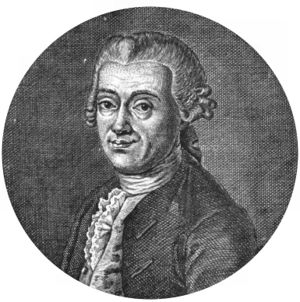يوهان دانيال تيتيوس
يوهان دانيال تيتيوس | |
|---|---|
 Johann Daniel Titius | |
| وُلِدَ | Johann Daniel Tietz 2 يناير 1729 |
| توفي | 16 ديسمبر 1796 (aged 67) |
| الجنسية | ألماني |
| اللقب | قانون تيتيوس-بوده |
| السيرة العلمية | |
| المجالات | الفلك، الفيزياء، علم الأحياء |
Johann Daniel Titius (born Johann Daniel Tietz(e), 2 January 1729 – 16 December 1796) كان فلكياً ألمانياً وأستاذ جامعي في ڤيتنبرگ.[1]
وُلِد تيتيوس في كونيتس (Chojnice)، پروسيا الملكية (أبعادية تابعة لتاج پولندا) ابناً لياكوب تيتس Tietz، التاجر وعضو المجلس عن كونيتس، وماريا دوروثيا (لقت عائلتها هانوڤ). اسمه الأصلي كان يوهان تيتس، ولكن كما كان مُتبعاً في القرن 18، حين أصبح أستاذاً جامعياً، قام بتلتين اسم عائلته إلى تيتيوس Titius. Tietz attended school in Danzig (Gdańsk) and studied at the University of Leipzig (1749–1752). He died in Wittenberg, Electorate of Saxony.[1]
. . . . . . . . . . . . . . . . . . . . . . . . . . . . . . . . . . . . . . . . . . . . . . . . . . . . . . . . . . . . . . . . . . . . . . . . . . . . . . . . . . . . . . . . . . . . . . . . . . . . . . . . . . . . . . . . . . . . . . . . . . . . . . . . . . . . . . . . . . . . . . . . . . . . . . . . . . . . . . . . . . . . . . . .
الفلك
He is best known for formulating the Titius–Bode law, and for using this rule to predict the existence of a celestial object at 2.8 AU from the sun which led to the 1801 discovery of what we now know as Ceres. He drew up the law in 1766, when he inserted his mathematical observation on planetary distances into a German translation of Charles Bonnet's book Contemplation de la Nature. In part because of this law, the first four minor planets were at first labeled as full-fledged planets. After a fifteen-year hiatus, other minor planets started to be discovered at steadily increasing rates, and Ceres and company were eventually relabeled as minor planets or asteroids. Because of its spherical shape, Ceres has had upgraded status as a dwarf planet since 2006.
The asteroid 1998 Titius and the crater Titius on the Moon are named in his honour.[2][3]
الفيزياء

Titius published a number of works on other areas in Physics, such as a set of conditions and rules for performing experiments, and he was particularly focused in thermometry.[4] In 1765 he presented a survey of thermometry up to that date. He wrote about the metallic thermometer constructed by Hanns Loeser. In his treatises on both theoretical and experimental physics, he incorporated the findings of other scientists, such as the descriptions of experiments written by Georg Wolfgang Kraft in 1738.[5]
علم الأحياء
Titius was also active in biology, particularly in classification of organisms and minerals.[4] His biological work was influenced by Linnaeus. Lehrbegriff der Naturgeschichte Zum ersten Unterrichte, his most extensive publication in biology, was on systematic classification of plants, animals, and minerals, as well as the elemental substances ether, fire, air, water and earth.[5]
المراجع
- ^ أ ب sächsische Biografie (in ألمانية)
- ^ Michael Nieto (1972). The Titius–Bode Law of Planetary Distances. Pergamon Press.
- ^ Clifford J. Cunningham (1988). Introduction to Asteroids. Richmond, Virginia: Willmann-Bell Inc.
- ^ أ ب "Johann Daniel Titius". Encyclopædia Britannica (online ed.). Encyclopædia Britannica, Inc.
- ^ أ ب "Titius (Tietz), Johann Daniel". Complete Dictionary of Scientific Biography (e-book ed.). New York: Charles Scribner's Sons. 2007. Retrieved 6 August 2015.
وصلات خارجية
- KDG Wittenberg: Prof. Dr. Joh. Daniel Titius
- Plants and Planets: The Law of Titius-Bode explained by H.J.R. Perdijk
- يوهان دانيال تيتيوس. In: Allgemeine Deutsche Biographie (ADB). Bd. 38, S. 380.